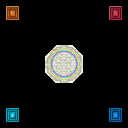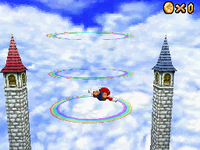Tower of the Wing Cap
Template:Galaxybox The Tower of the Wing Cap, called the Wing Cap Course in the original message that appears upon the player entering, the Wind Cap Tower in Australia's Nintendo Magazine System,[1] and simply labeled ? Switch in the DS remake (although "Tower of the Wing Cap" was still in use by Prima Games),[2] is a castle tower in the sky that contains the Wing Cap Switch, appearing in Super Mario 64 and Super Mario 64 DS. The entrance is located on the first floor of the Mushroom Castle. Once the player has collected ten Power Stars (14 in Super Mario 64 DS), sunlight will be shining down from the ceiling onto the rug in the center of the room. If Mario stands in the sunlight and looks up, he will be transported to the level. The cloud pattern on the ceiling can also be seen on the second floor in normal paintings that Mario cannot enter, and even later in the entrance holes of Rainbow Ride and Wing Mario Over the Rainbow. Although the sunlight will disappear once the red switch has been activated, Mario can still return to the level by standing in the same spot and looking up.
Layout
In Super Mario 64, Mario will immediately appear in flight as Wing Mario. Upon landing on the tower, Mario will be able to press the red Cap Switch, which in turn will make all the red ! Blocks solid. A Power Star can also be found here after the player collects the eight Red Coins. This is the only location that Mario enters as Wing Mario; in other courses, he must collect a Wing Cap from a red ! Block and either launch from a cannon or triple-jump to take off.
In Super Mario 64 DS, the red switch is changed from a ! Switch to the namesake ? Switch, which likewise activates all of the ? Blocks in the game. In addition, only Mario is granted wings upon entering; if any characters other than Mario access the course, they still flip as they normally do during a course intro but plummet into the abyss, which promptly transports them back into the castle.
When Mario accesses the ? Switch course for the first time, it is mistakenly described as the "? Switches of Rainbow Tower" despite only one such switch existing in this version.
If the player falls below the stage, they will be returned to the castle lobby with no life lost.
Mission
There is only one Power Star to collect in this area. Using the wings that he is granted upon entering the level, Mario must fly around the area and collect the eight Red Coins floating in the air in the four compass directions. The Red Coins are found in pairs. Due to the fact that Mario slowly loses altitude while flying, he will have to reenter the level and try again if he drops below the point at which the coins are. Additionally, each pair of coins going counterclockwise starting from the eastern side of the tower is lower than the last, meaning that it is most efficient to start with that pair while going in that direction. Once all the Red Coins are collected, the Power Star will appear at the Star Marker on top of the tower.
Names in other languages
Super Mario 64
| Language | Name | Meaning | Notes |
|---|---|---|---|
| Japanese | はばたけ!はねスイッチへ[?] Habatake! Hane Suicchi e |
Flap! To the Wing Switch | |
| Chinese | 飞行帽之塔[?] Fēixíngmào Zhī tǎ |
Tower of the Wing Cap | |
| German | Roter Schalterpalast[?] | Red Switch Palace |
Super Mario 64 DS
| Language | Name | Meaning | Notes |
|---|---|---|---|
| Japanese | びっくり!ハテナスイッチ[?] Bikkuri! Hatena Suicchi |
Surprise! ? Switch | |
| Chinese | 令人惊奇的?开关[?] Lìngrén Jīngqí de ?Kāiguān |
The Surprising ? Switch | |
| German | ?-Schalter[?] | ? Switch | |
| Italian | Torre Arcobaleno L'Interruttore ?[?] |
Rainbow Tower The ? Switch |
|
| Korean | 깜짝!?스위치[?] Kkamjjak! ?-Seuwichi |
Surprise! ? Switch | |
| Spanish | El Interruptor ?[?] | The ? Switch |
References in other games
- Mario's Rainbow Castle from Mario Party also resembles the area. Mario's Wing Cap even appears on a tower on the board.
- Noki Bay in Super Mario Sunshine is accessed in a similar way: by standing on a similar pattern on the streets of Delfino Plaza and staring at the real sun.
- The tower the Sand Bird flies around in Super Mario Sunshine vaguely resembles the Tower of the Wing Cap, due to a similar layout.
- In Super Mario Odyssey, the Power Moon "Light from the Ceiling" obtained in the Mushroom Kingdom is found exactly the same way that this level is accessed: by looking up in the middle of the foyer.


